I am the lead instrument scientist on the VESUVIO neutron spectrometer at the ISIS Neutron and Muon Source. There are two reasons why VESUVIO is a unique instrument in the world:
- VESUVIO uses a technique referred to as neutron Compton scattering (NCS). VESUVIO makes NCS possible by providing high-energy (epithermal) neutrons. The NCS technique, unlike other neutron techniques, measures one atom at a time, thereby enabling the elucidation of potentials of mean force (PMF) and mean force constants (MFC) of individual atomic species. Knowing the values of MFCs, one can assess mechanical properties of condensed matter systems, such as cohesion and fracture toughness, as well as thermodynamic properties. Knowing the shapes of PMFs, one can assess nuclear quantum effects (NQEs), such as nuclear quantum tunnelling (NQT) and delocalisation (NQD). NQT and NQD are important for the characterisation of solid-state diffusion of nuclei and nuclear dynamics of hydrogen bonds (HBs), with important ramifications in biology, pharmacy, and materials science.
- Apart from NCS, VESUVIO offers 4 additional techniques: neutron transmission (NT), diffraction (ND), Prompt-Gamma Activation Analysis (PGAA), and Neutron-resonance capture analysis (NRCA). In this way, VESUVIO harvests all neutrons produced by ISIS, covering an unprecedented range of neutron energies, from one-thousandth of an electron volt (thermal) to thousands of electron volts (epithermal).
My background: I received a Master of Physics (1996) and a PhD (2001) in biological nuclear magnetic resonance (NMR) at the Faculty of Physics of the Jagellonian University in Cracow, Poland. I continued my research career in biological NMR and electron paramagnetic resonance (EPR) as a postdoctoral research associate (PDRA) at the Free University of Berlin. In 2003, I joined the QUACS Marie Curie Research Training Network and started working on the applications of neutron Compton scattering (NCS) in nuclear chemical dynamics of condensed matter systems and molecules at the Technical University Berlin. In 2007, I received a fellowship from the German Research Foundation to continue my research using the NCS technique at the ISIS Neutron and Muon Source. In 2009, as a PDRA at the University of Durham and Oxford, I joined the SPINACH project, building a fast spin dynamics simulation library that supports NMR, EPR, and many other forms of Magnetic Resonance spectroscopy. In 2011 I was appointed Senior Lecturer in Physical Chemistry at the School of Science and Technology, Nottingham Trent University (NTU). Since 2012, while working as a program officer at the National Science Centre in Cracow, Poland and collaborating with the STFC within the AStroparticle Physics European Research Area network, ASPERA-2, I was a visiting fellow at the NTU and the ISIS Neutron and Muon Source. In 2015 I obtained a position as an instrument scientist in electron volt neutron spectroscopy at the ISIS Neutron and Muon Source.
ORCID: https://orcid.org/0000-0003-0307-6871
Research Interest (and selected recent publications)
My area of expertise includes NMR and EPR spectroscopy and relaxation theory, as well as neutron spectroscopy, including Compton scattering in condensed matter systems and molecules.
Nuclear quantum effects in glassy and disordered materials
Krzystyniak M, Syrykh G, Stolyarov A, Sadykov RA, Romanelli G. Force constant disorder in the Ni44Nb56 bulk metallic glass as observed by deep inelastic neutron scattering augmented by isotopic substitution. Physica Scripta 2022, 97, doi: 10.1088/1402-4896/ac698a
Witek M, Krzystyniak M, Romanelli G, Witczak T. Glass Transition in Rice Pasta as Observed by Combined Neutron Scattering and Time-Domain NMR. Polymers 2021, 13, doi: 10.3390/polym13152426
Krzystyniak M, Druzbicki K, Tolnai I, Fabian M. Local structure and dynamics of tungsten oxide-based glasses: insights from concurrent neutron diffraction and Compton scattering. Journal of Physics Communications 2021, 5, doi: 10.1088/2399-6528/ac1508
Krzystyniak M, Druzbicki K, Rudic S, Fabian M. Positional, isotopic mass and force constant disorder in molybdate glasses and their parent metal oxides as observed by neutron diffraction and Compton scattering. Journal of Physics Communications 2020, 4, doi: 10.1088/2399-6528/abb8ee
Krzystyniak M, Syrykh G, Stolyarov A, Sadykov RA, Armstrong J, da Silva I, Romanelli G, Fernandez-Alonso F. Mass-selective neutron spectroscopy of glassy versus polycrystalline structures in binary mixtures of beryllium and zirconium. Journal of Physics: Conference Series, 2018, 1055, doi: 10.1088/1742-6596/1055/1/012004
Ding HM, Liu Q, Wang XL, Fan XL, Krzystyniak M, Glandut N, Li C. Effects of boron addition on the microstructure and properties of in situ synthesis TiC reinforced Cu-Ti-C composites. Journal of Alloys and Compounds 2018, 766:66-73, doi: 10.1016/j.jallcom.2018.06.327
Syrykh GF, Stolyarov AA, Krzystyniak M, Romanelli G, Sadykov RA. Temperature Dependence of the Kinetic Energy in the Zr40Be60 Amorphous Alloy. Jetp Letters 2017, 105:591-594, doi: 10.1134/S0021364017090041
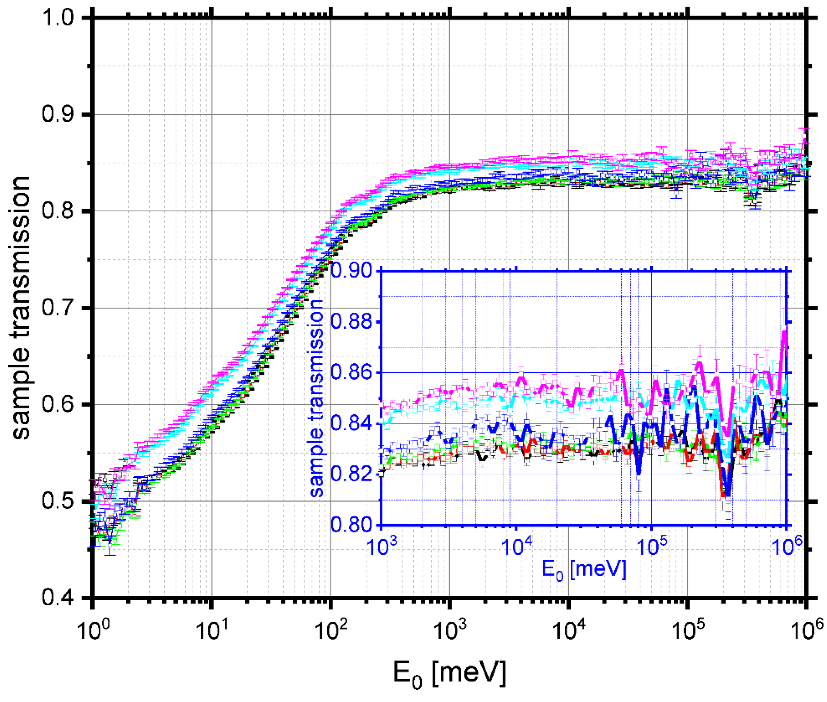
Figure 1. Neutron transmission curves, recorded in a wide range of incident neutron energies, between 1 meV and 1000 eV and at a set of temperatures in the range of −20 °C to 80 °C for the sample of rice pasta with the water content 0.1069 g/g d.m. Black, red, green, blue, cyan, and magenta traces with data points and error bars show data recorded at −20, 0, 20, 40, 60, and 80 °C. Inset: the close-up of the transmission in the epithermal neutron range defining the scattering power of the sample as a function of temperature. See ref. Witek M, Krzystyniak M, Romanelli G, Witczak T. Glass Transition in Rice Pasta as Observed by Combined Neutron Scattering and Time-Domain NMR. Polymers 2021, 1.
Nuclear quantum effects in hydrogen bonded systems
Lalik E, Druzbicki K, Irvine G, Gutmann M, Rudic S, Manuel P, Petricek V, Krzystyniak M. Interplay between Local Structure and Nuclear Dynamics in Tungstic Acid: A Neutron Scattering Study. Journal of Physical Chemistry C 2021, 125: 23864-23879, doi: 10.1021/acs.jpcc.1c05121
Fjellvag OS, Krzystyniak M, Vajeeston P, Sjastad AO, Armstrong J. A combined deep inelastic neutron scattering and ab initio lattice dynamics study of the hydride anion dynamics and bonding in La2LiHO3 oxyhydride. Journal of Physics Communications 2019, 3, doi: 10.1088/2399-6528/ab4be6
Kolesnikov AI, Reiter GF, Prisk TR, Krzystyniak M, Romanelli G, Wesolowski DJ, Anovitz LM. Inelastic and deep inelastic neutron spectroscopy of water molecules under ultra-confinement. Journal of Physics: Conference Series, 2018, 1055, doi: 10.1088/1742-6596/1055/1/012002
Andreani C, Senesi R, Krzystyniak M, Romanelli G, Fernandez-Alonso FF. Experimental studies of nuclear quantum effects in condensed matter: the case of water. Rivista Del Nuovo Cimento 2018, 41:291-340, doi: 10.1393/ncr/i2018-10147-9
Krzystyniak M, Druzbicki K, Romanelli G, Gutmann MJ, Rudic S, Imberti S, Fernandez-Alonso F. Nuclear dynamics and phase polymorphism in solid formic acid. Physical Chemistry Chemical Physics 2017, 19:9064-9074, doi: 10.1039/c7cp00997f
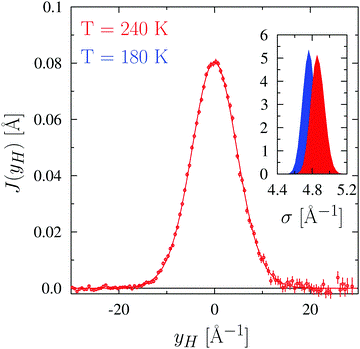
Figure 2. Isolated and focused proton NCS for solid formic acid at T = 240 K. Solid red line and points with error bars represent the fitting curve and the experimental data, respectively. The inset shows the distributions of the fitted widths of the proton NMDs obtained with the FABADA algorithm. See ref. Krzystyniak M, Druzbicki K, Romanelli G, Gutmann MJ, Rudic S, Imberti S, Fernandez-Alonso F. Nuclear dynamics and phase polymorphism in solid formic acid. Physical Chemistry Chemical Physics 2017, 19:9064-9074
Nuclear quantum effects in functional materials
Kumar A, Warshi MK, Sagdeo A, Krzystyniak M, Rudic S, Adroja DT, Da Silva I, Sagdeo PR. Origin of natural and magnetic field induced polar order in orthorhombic PrFe1/2Cr1/2O3. Physical Review B 2021, 104, doi: 10.1103/PhysRevB.104.035101
Ulpiani P, Romanelli G, Onorati D, Krzystyniak M, Andreani C, Senesi R. The effective isotropy of the hydrogen local potential in biphenyl and other hydrocarbons. Journal of Chemical Physics 2020, 153, doi: 10.1063/5.0029578
Krzystyniak M, Richards SE, Seel AG, Fernandez-Alonso F. Mass-selective neutron spectroscopy of lithium hydride and deuteride: Experimental assessment of the harmonic and impulse approximations. Physical Review B 2013, 88, doi: 10.1103/PhysRevB.88.184304
Boysen H, Lerch M, Fernandez-Alonso F, Krzystyniak M, Lalowicz ZT, Chatzidimitriou-Dreismann CA, Tovar M. On the mechanism of proton conductivity in H3OSbTeO6. Journal of Physics and Chemistry of Solids 2012, 73:808-817, doi: 10.1016/j.jpcs.2012.02.004
Krzystyniak M, Adams MA, Lovell A, Skipper NT, Bennington SM, Mayers J, Fernandez-Alonso F. Probing the binding and spatial arrangement of molecular hydrogen in porous hosts via neutron Compton scattering. Faraday Discussions 2011, 151:171-197, doi: 10.1039/c1fd00036e
Krzystyniak M, Abdul-Redah T. Proton momentum distribution in solid and liquid HF. Physical Review B 2010, 82, doi: 10.1103/PhysRevB.82.064301
Krzystyniak M. Nuclear momentum distribution in solid and liquid HF from ab initio calculation. Journal of Chemical Physics 2010, 133, doi: 10.1063/1.3502474
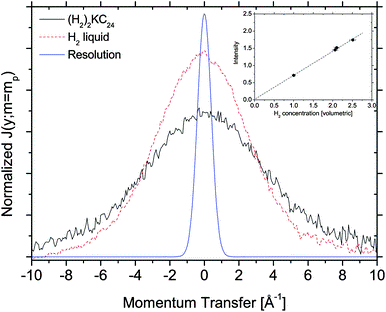
Figure 3. Isotropic proton Compton profiles for (H2)2KC24 and liquid H2 at T = 20 K. For the purposes of comparison, both profiles have been normalised to unity. The blue curve corresponds to the instrumental resolution rescaled by an arbitrary constant. The inset shows the dependence of the total scattered intensity on volumetric dosage. Horizontal error bars in the inset correspond to our uncertainty in measuring H2 uptakes volumetrically. See ref. Krzystyniak M, Adams MA, Lovell A, Skipper NT, Bennington SM, Mayers J, Fernandez-Alonso F. Probing the binding and spatial arrangement of molecular hydrogen in porous hosts via neutron Compton scattering. Faraday Discussions 2011, 151:171-197
Neutron Moderating Materials
Dawidowski J, Palomino LAR, Romanelli G, Cuello GJ, Damian JIM, Robledo JI, Krzystyniak M. Determination of effective temperatures of hydrogenated and deuterated alcohols using the VESUVIO spectrometer. Nuclear Instruments & Methods in Physics Research Section a-Accelerators Spectrometers Detectors and Associated Equipment 2021, 989, doi: 10.1016/j.nima.2020.164948
Damian JIM, Dawidowski J, Granada RJ, Cantargi F, Romanelli G, Helman C, Krzystyniak M, Skoro G, Roubtsov D. Experimental validation of the temperature behavior of the ENDF/B-VIII.0 thermal scattering kernel for light water. Nd 2019: International Conference on Nuclear Data for Science and Technology 2020, 239,
doi: 10.1051/epjconf/202023914001
Cantargi F, Dawidowski J, Helman C, Damian JIM, Granada RJ, Romanelli G, Cuello JG, Skoro G, Krzystyniak M. Validated scattering kernels for triphenylmethane at cryogenic temperatures. Nd 2019: International Conference on Nuclear Data for Science and Technology 2020, 239, doi: 10.1051/epjconf/202023914002
Romanelli G, Minniti T, Skoro G, Krzystyniak M, Taylor J, Fornalski D, Fernandez-Alonso F. Visualization of the Catalyzed Nuclear-Spin Conversion of Molecular Hydrogen Using Energy-Selective Neutron Imaging. Journal of Physical Chemistry C 2019, 123:11745-11751, doi:10.1021/acs.jpcc.9b01858
Palomino LAR, Dawidowski J, Helman C, Damian JIM, Romanelli G, Krzystyniak M, Rudic S, Cuello GJ. Determination of the scattering cross section of calcium using the VESUVIO spectrometer. Nuclear Instruments & Methods in Physics Research Section a-Accelerators Spectrometers Detectors and Associated Equipment 2019, 927:443-450, doi: 10.1016/j.nima.2019.02.072
Romanelli G, Rudic S, Zanetti M, Andreani C, Fernandez-Alonso F, Gorini G, Krzystyniak M, Skoro G. Measurement of the para-hydrogen concentration in the ISIS moderators using neutron transmission and thermal conductivity. Nuclear Instruments & Methods in Physics Research Section a-Accelerators Spectrometers Detectors and Associated Equipment 2018, 888:88-95, doi: 10.1016/j.nima.2018.01.039
Palomino LAR, Dawidowski J, Damian JIM, Cuello GJ, Romanelli G, Krzystyniak M. Neutron total cross-section of hydrogenous and deuterated 1-and 2-propanol and n-butanol measured using the VESUVIO spectrometer. Nuclear Instruments & Methods in Physics Research Section a-Accelerators Spectrometers Detectors and Associated Equipment 2017, 870:84-89, doi: 10.1016/j.nima.2017.07.027
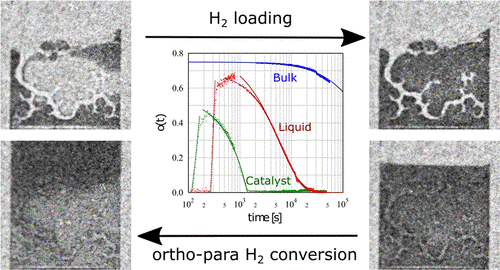
Figure 4. We present time-resolved neutron-imaging results on the ortho- to para-hydrogen conversion in the presence of a nanoparticle powder of the ferromagnetic catalyst γ-Fe2O3. In particular, we were able to characterize the conversion rate as a function of time and position of molecular hydrogen with respect to the catalyst. Results are reported for liquid and solid molecular hydrogen at 15 and 10 K, respectively. We discuss how newly generated para-hydrogen poisons the catalyst, thus slowing the process and preventing the full conversion of large quantities of condensed molecular hydrogen, and we underline how the performance of the conversion critically depends on the loading procedure. Moreover, we suggest how a honeycomb distribution of the catalyst in a vessel can boost the conversion rates while minimizing the amount of material needed. Finally, we show how state-of-the-art energy-selective imaging using pulsed neutrons can be used to provide molecular specificity beyond what is currently possible for in situ and operando kinetic studies, with direct industrial applications such as the well-known “boil-off" problem associated with the low-temperature storage of molecular hydrogen.. See ref. Romanelli G, Minniti T, Skoro G, Krzystyniak M, Taylor J, Fornalski D, Fernandez-Alonso F. Visualization of the Catalyzed Nuclear-Spin Conversion of Molecular Hydrogen Using Energy-Selective Neutron Imaging. Journal of Physical Chemistry C 2019, 123:11745-11751
Instrument and technique Development
Krzystyniak M, Romanelli G, Fernandez-Alonso F. Non-destructive quantitation of hydrogen via mass-resolved neutron spectroscopy. Analyst 2019, 144:3936-3941,
doi: 10.1039/c8an01729h
Ulpiani P, Romanelli G, Arcidiacono L, Onorati D, Festa G, Krzystyniak M, Schooneveld E, Fernandez-Alonso F, Andreani C, Senesi R. Enhancement of counting statistics and noise reduction in the forward-scattering detectors on the VESUVIO spectrometer. Vii International Workshop on Electron-Volt Neutron Spectroscopy 2018, 1055, doi: 10.1088/1742-6596/1055/1/012008
Romanelli G, Krzystyniak M, Festa G, Andreani C, Fernandez-Alonso F, Senesi R. The road to a station for epithermal and thermal neutron analysis. Vii International Workshop on Electron-Volt Neutron Spectroscopy 2018, 1055, doi: 10.1088/1742-6596/1055/1/012017
Romanelli G, Krzystyniak M, Fernandez-Alonso F. Neutron-resonance capture analysis on the VESUVIO spectrometer: Towards high-throughput material characterisation. Vii International Workshop on Electron-Volt Neutron Spectroscopy 2018, 1055, doi: 10.1088/1742-6596/1055/1/012015
Onorati D, Andreani C, Arcidiacono L, Fernandez-Alonso F, Festa G, Krzystyniak M, Romanelli G, Ulpiani P, Senesi R. Gamma background characterization on VESUVIO: before and after the moderator upgrade. Vii International Workshop on Electron-Volt Neutron Spectroscopy 2018, 1055, doi: 10.1088/1742-6596/1055/1/012009
Krzystyniak M, Romanelli G, Tolchenov R, Gigg M, Hewer B, Fernandez-Alonso F. Nuclear kinetic energies from final-state effects in the harmonic limit. Vii International Workshop on Electron-Volt Neutron Spectroscopy 2018, 1055, doi: 10.1088/1742-6596/1055/1/012011
Krzystyniak M, Romanelli G, Fabian M, Gutmann M, Festa G, Arcidiacono L, Gigg M, Druzbicki K, Andreani C, Senesi R, et al. VESUVIO plus : The Current Testbed for a Next-generation Epithermal Neutron Spectrometer. 22nd Meeting of the International Collaboration on Advanced Neutron Sources (Icans Xxii) 2018, 1021,
doi: 10.1088/1742-6596/1021/1/012026
Krzystyniak M, Romanelli G, Druzbicki K, Tolchenov R, Gigg M, Hewer B, Fernandez-Alonso F. Model selection in neutron Compton scattering - a Bayesian approach with physical constraints. Vii International Workshop on Electron-Volt Neutron Spectroscopy 2018, 1055, doi: 10.1088/1742-6596/1055/1/012012
Di Giulio A, Zanetti M, Romanelli G, Krzystyniak M, Senesi R, Fernandez-Alonso F. A McStas simulation of the incident neutron beam on the VESUVIO spectrometer. Vii International Workshop on Electron-Volt Neutron Spectroscopy 2018, 1055, doi: 10.1088/1742-6596/1055/1/012014
Dawidowski J, Palomino LAR, Romanelli G, Krzystyniak M. Procedure for the determination of effective temperatures employing VESUVIO spectrometer. Vii International Workshop on Electron-Volt Neutron Spectroscopy 2018, 1055, doi: 10.1088/1742-6596/1055/1/012013
Romanelli G, Krzystyniak M, Senesi R, Raspino D, Boxall J, Pooley D, Moorby S, Schooneveld E, Rhodes NJ, Andreani C, et al. Characterisation of the incident beam and current diffraction capabilities on the VESUVIO spectrometer. Measurement Science and Technology 2017, 28, doi: 10.1088/1361-6501/aa7c2a
Andreani C, Krzystyniak M, Romanelli G, Senesi R, Fernandez-Alonso F. Electron-volt neutron spectroscopy: beyond fundamental systems. Advances in Physics 2017, 66:1-73, doi: 10.1080/00018732.2017.1317963
Romanelli G, Krzystyniak M. On the line-shape analysis of Compton profiles and its application to neutron scattering. Nuclear Instruments & Methods in Physics Research Section a-Accelerators Spectrometers Detectors and Associated Equipment 2016, 819:84-88, doi: 10.1016/j.nima.2016.02.089
Jackson S, Krzystyniak M, Seel AG, Giggi M, Richards SE, Fernandez-Alonso F. VESUVIO Data Analysis Goes MANTID. Vi Workshop in Electron Volt Neutron Spectroscopy: Frontiers and Horizons 2014, 571, 10.1088/1742-6596/571/1/012009
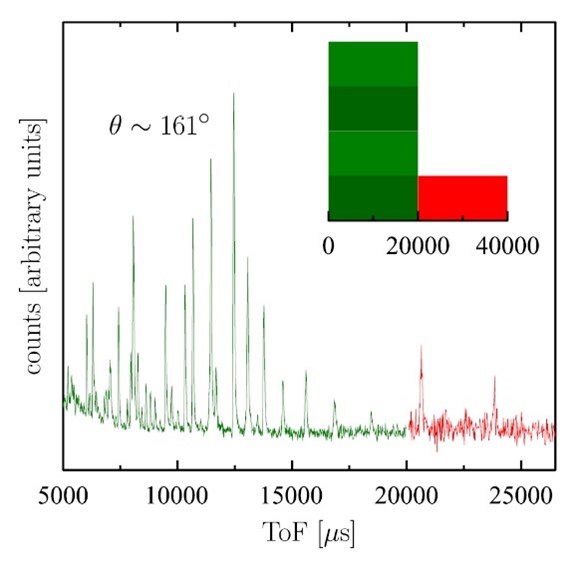
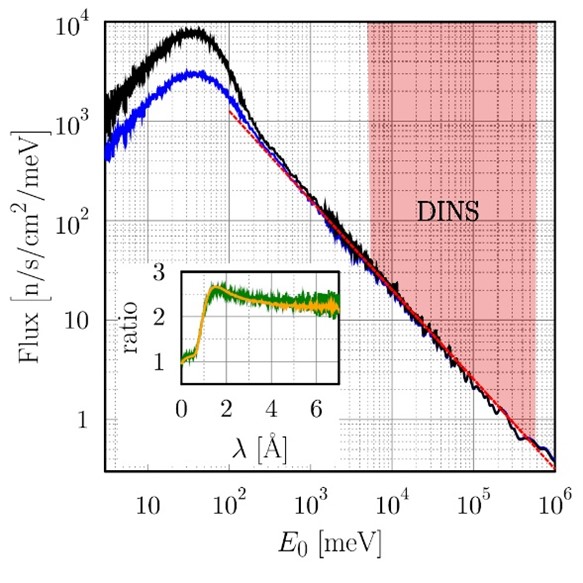
Figure 5. Left: Bragg peaks from Na2Ca3AlF14 measured by a single detector at a scattering angle ∼161°. Data correspond to an integrated proton current of 1.6 mAh. Right: Incident neutron flux at the sample position as measured by the calibrated monitor before the change to the water moderator (blue line) and measured by the nGEM after the CWM (black line). The red dashed line is proportional to E0-0.9 and the region shadowed in red represents the energy range used in DINS. The insert shows the spectrum of the incident neutron beam after the change to the water moderator normalised to the spectrum before the change. The orange spectrum has been obtained from the VESUVIO incident monitor while the green spectrum from the nGEM detector. See ref. Romanelli G, Krzystyniak M, Senesi R, Raspino D, Boxall J, Pooley D, Moorby S, Schooneveld E, Rhodes NJ, Andreani C, et al. Characterisation of the incident beam and current diffraction capabilities on the VESUVIO spectrometer. Measurement Science and Technology 2017, 28
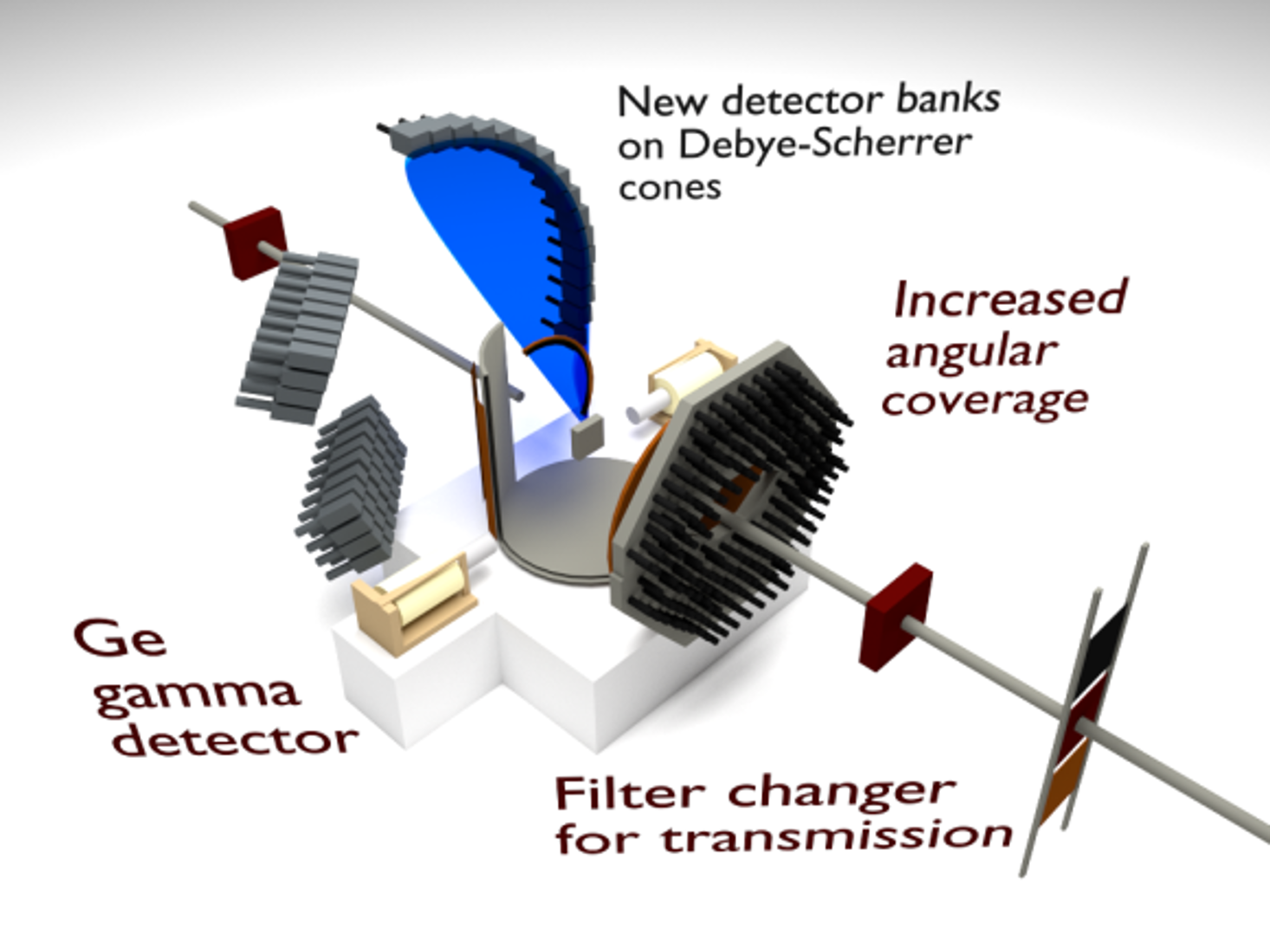
Figure 6. Schematic diagram of a next-generation eV neutron spectrometer. Front and backscattering detector banks are positioned along Debye–Scherrer cones. YAP detectors normal to the beam direction are used for the analysis of γ -rays from the resonant capture of eV neutrons. The Ge detectors immediately below these can be used for energy-resolved γ -ray analysis such as PGAA. A multiple-stage foil-changer in the incident beam is used to effect further energy selection. The black arrow above the sample indicates the possibility of utilising other experimental probes in situ. See ref. Andreani C, Krzystyniak M, Romanelli G, Senesi R, Fernandez-Alonso F. Electron-volt neutron spectroscopy: beyond fundamental systems. Advances in Physics 2017, 66:1-73
Selected Scientific Highlights
The past, present and future of inelastic neutron scattering
Watching hydrogen flip its spin
Past & Selected Research Highlights
Szymocha AM, Lalowicz ZT, Birczynski A, Krzystyniak M, Stoch G, Gora-Marek K. Water Confinement in Faujasite Cages: A Deuteron NMR Investigation in a Wide Temperature Range. 2. Spectra and Relaxation at High Temperature. Journal of Physical Chemistry A 2014, 118:5371-5380, doi: 10.1021/jp502827x
Szymocha AM, Birczynski A, Lalowicz ZT, Stoch G, Krzystyniak M, Gora-Marek K. Water Confinement in Faujasite Cages: A Deuteron NMR Investigation in a Wide Temperature Range. 1. Low Temperature Spectra. Journal of Physical Chemistry A 2014, 118:5359-5370, doi: 10.1021/jp504648s
Krzystyniak M, Edwards LJ, Kuprov I. Destination state screening of active spaces in spin dynamics simulations. Journal of Magnetic Resonance 2011, 210:228-232,
doi: 10.1016/j.jmr.2011.03.010
Hogben HJ, Krzystyniak M, Charnock GTP, Hore PJ, Kuprov I. Spinach - A software library for simulation of spin dynamics in large spin systems. Journal of Magnetic Resonance 2011, 208:179-194, doi:10.1016/j.jmr.2010.11.008
Charnock GTP, Krzystyniak M, Kuprov I. Molecular structure refinement by direct fitting of atomic coordinates to experimental ESR spectra. Journal of Magnetic Resonance 2012, 216:62-68, doi: 10.1016/j.jmr.2012.01.003
Lalowicz ZT, Stoch G, Birczynski A, Punkkinen M, Krzystyniak M, Gora-Marek K, Datka J. Dynamics of hydroxyl deuterons and bonded water molecules in NaDY(0.8) zeolite as studied by means of deuteron NMR spectroscopy and relaxation. Solid State Nuclear Magnetic Resonance 2010, 37:91-100, doi: 10.1016/j.ssnmr.2010.04.004
Krzystyniak M, Shen G, Golbeck JH, Antonkine ML. Investigation of water bound to photosystem I with multiquantum filtered O-17 nuclear magnetic resonance. Journal of Chemical Physics 2008, 128, doi: 10.1063/1.2813891
Xu W, Chitnis P, Valieva A, van der Est A, Pushkar YN, Krzystyniak M, Teutloff C, Zech SG, Bittl R, Stehlik D, et al. Electron transfer in cyanobacterial photosystem I - I. Physiological and spectroscopic characterization of site-directed mutants in a putative electron transfer pathway from A(0) through A(1) to F-x. Journal of Biological Chemistry 2003, 278:27864-27875, doi: 10.1074/jbc.M302962200
Lehoux A, Krzystyniak M, Baguet E. A faster way to characterize by triple-quantum-filtered O-17 NMR water molecules strongly bound to macromolecules in solution. Journal of Magnetic Resonance 2001, 148:11-22, doi: 10.1006/jmre.2000.2233
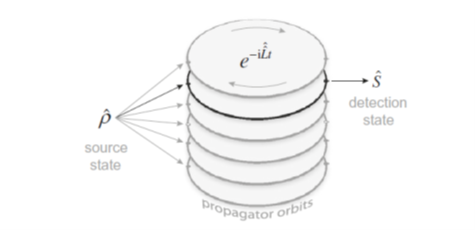
Figure 7. Schematic illustration of destination state screening of time domain Liouville space spin dynamics simulations. The orbits induced in the system state space by the action of a given time propagator do not intersect and may be simulated separately. For a given initial state ρ0 and detection state S, only the orbits containing contributions from both ρ0 and S need to be simulated. See ref. Krzystyniak M, Edwards LJ, Kuprov I. Destination state screening of active spaces in spin dynamics simulations. Journal of Magnetic Resonance 2011, 210:228-232

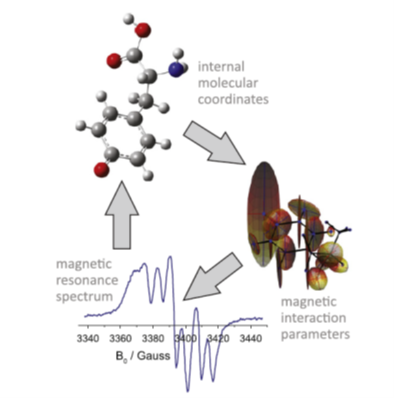
Figure 8. A schematic of the direct structure fitting procedure: molecular coordinates are supplied to a quantum chemistry package, the resulting magnetic parameters are fed to a spin dynamics simulation package (Spinach software was used in this work) and the squared norm of the deviation from the experimental spectrum is computed. This deviation is iteratively minimized with respect to the molecular coordinates, with a constraint on the molecular energy to stay within the thermally accessible energy range. See ref. Charnock GTP, Krzystyniak M, Kuprov I. Molecular structure refinement by direct fitting of atomic coordinates to experimental ESR spectra. Journal of Magnetic Resonance 2012, 216:62-68
